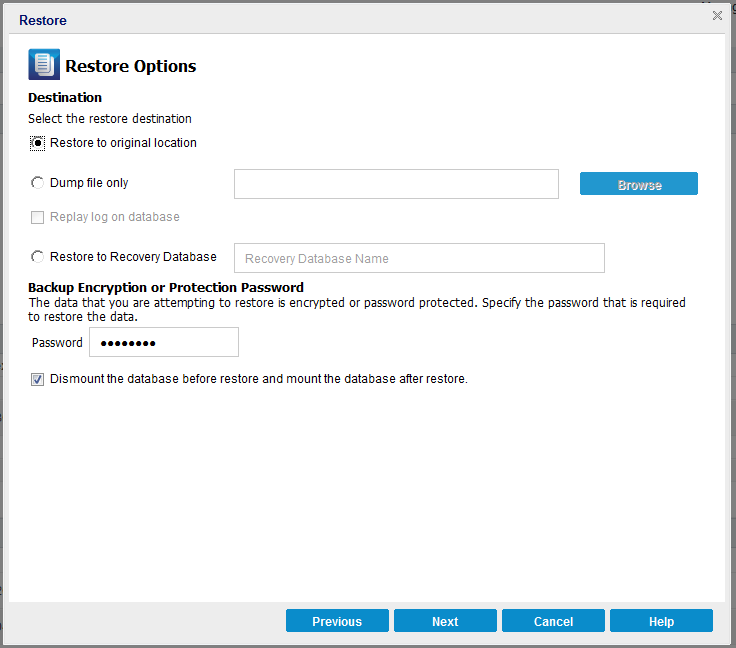Define the Restore Options
After you specify a recovery point and content to restore, define the copy options for the selected recovery point.
Follow these steps:
- From the Restore Options dialog, select the restore destination.
- Select the destination for the restore.
- The available options are to restore to the original location of the backup, restore the dump file only, or restore to a Recovery Storage Group/Recovery Mailbox Database.
- The database to be restored is in Dismounted status.
- The database is not restored unexpectedly.
- If checked, specifies that the recovery process will automatically dismount the Microsoft Exchange database before the restore process and then mount the database after the restore process is completed. In addition, if checked, this option will also allow the Microsoft Exchange database to be overwritten during the restore.
- If unchecked, specifies that the recovery process will not automatically dismount the Microsoft Exchange database before recovery and mount the database after recovery.
- Click Next.
- The Restore Summary dialog opens.

Restore to original location
Restores to the original location from where the backup image was captured.
Dump file only
Restores the dump files only.
For this option, Arcserve UDP Agent (Windows) will restore the Microsoft Exchange database file to a specified folder, and will not bring it online after recovery. You can then use it to mount on Microsoft Exchange Server manually.
Note: When a Recovery Mailbox Database exists, restore with Dump file only option will fail.
Replay log on database
Specifies that when the database files are dumped to the destination folder, you can replay Microsoft Exchange transaction log files and commit them to the database.
Dismount the database before restore and mount the database after restore
Typically before a restore, Microsoft Exchange will perform some checks to help ensure the following:
To protect a Microsoft Exchange production database from being restored unexpectedly, a switch is added to allow the database to be overwritten during the restore process. Microsoft Exchange will refuse to restore a database if this switch is not set.
For Arcserve UDP Agent (Windows), these two options are controlled by this "Dismount the database before restore and mount the database after restore" option. With this option, Arcserve UDP Agent (Windows) lets you launch the restore process automatically without any manual operations. (You can also specify to dismount/mount database manually).
The Microsoft Exchange administrator would have to perform some manual operations such as dismount the Microsoft Exchange database, set the Allow Overwrite flag on the database, and mount the Microsoft Exchange database. (The recovery procedure is performed by Exchange during the mounting of the database).
In addition, if unchecked, this option does not allow the Microsoft Exchange database to be overwritten during restore.
Restore to Recovery Database (Microsoft Exchange 2010 and 2013)
Restores the database to a Recovery Database. A Recovery Database is a database that can be used for recovery purposes. You can restore a Microsoft Exchange Mailbox Database from a backup to a Recovery Database and then recover and extract data from it, without affecting the production database that is being accessed by end users.
Before restoring a Microsoft Exchange 2010 or Exchange 2013 database to a Recovery Database, you must first create a Recovery Database.